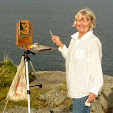Green Ledge 2003
Rachel Carson Marsh 2014
When I first started painting, I used very bright colors, mostly green, blue, purple, yellow, and white. I didn’t understand that there are 3 dimensions to any patch of paint you put on a canvas: hue (the named color on the color wheel), value (how light or dark it is), and chroma (intensity or saturation). Think about the last one as bright (highly saturated) versus dull (grayed down). Grays are very important to balance areas that are bright, but mixing grays can be confusing, since they can become muddy. As I watch individual painters evolve over time, I often see the same progression I went through; from bright, out of the tube colors, through a phase where the artist is trying their best to paint what they see in nature, to a place where they create their own color palette. And here I’m not talking about what you squeeze out onto your physical palette, but what you mix with those colors and place on your paintings.
Here are a few things I’ve learned.
Guideline 1: Mix efficiently
Regardless of what color
you’re trying to create, if you don’t know how to mix efficiently, you’ll end
up with lots of paint you can’t use.
Start by mixing only two colors together. A primary and white is the simplest example. Let’s use white and ultramarine blue. Squeeze out some of both, with some space in between. Is the blue you want closer to the tube ultramarine blue or to white in value? If it’s closer to the ultramarine blue, then pull a little of the white into your ultramarine blue pile and mix them together with the back of your palette knife. It will probably still be too dark, so pull in some more white and repeat mixing. Continue to do this until you have the color and value that you want. If what you wanted was closer to the white in value, then do the opposite, pull a little ultramarine blue into the white pile, mix, and repeat as above.
Contrast the above with
plopping down two pretty much equal blobs of ultramarine blue and white and
simply mixing them together. To get what you want, you’re going to have to add
more and more of one or the other, and you’ll have LOTS of paint by the time
you’re done.
The above is illustrated in
this video.
Guideline 2: Use a limited
palette
Color mixing chart for a limited palette of lemon (Hansa) yellow, cadmium yellow, cadmium red, quinacridone red, ultramarine blue, and phthalo blue, with white (+W)
The more pigments you mix together, the more likely you are to get mud. A limited palette helps prevent this. You’ll also spend less money on paint and have less paint to carry around if you use a limited palette. What is this limited palette? Ideally it would be just the primary colors and white. The secondaries can be made from the primaries, but not vice a versa (try it if you’re not sure). The primary colors tend to have only one pigment in the tube. The problem is that none of them are exactly the color we see on the color wheel. Ultramarine blue is a little on the purple side of blue, and cobalt and phthalo blue are a little on the green side. But we can take advantage of that. If we mix a red and a blue that lean to the purple side together we get a really bright purple. And if we mix the red that leans toward yellow and the blue that leans toward green, we get a grayed down version (see the color mixing chart above). So if we have two of each primary and some white we can make everything we need, with a minimal chance of mud, and control over our grays. My paintings improved so much once I mastered this!
Guideline 3: Limit your use of white
White isn’t always the best
way to make a color lighter, yellow can be a better choice, especially with
reds. And it’s best to first block in the darks and then the lights (those
mixtures that contain white), because it’s very hard to paint dark into light paint
while both are wet.
A Great Exercise:
To practice paint mixing, get
some pleasing color chips from the hardware paint department, and try mixing
them. When you’re close, put a little of the mixture on the paint chip. Is the
color right? Squint to make sure the value is right. Thanks to Leslie Saeta for
this idea.





No comments:
Post a Comment